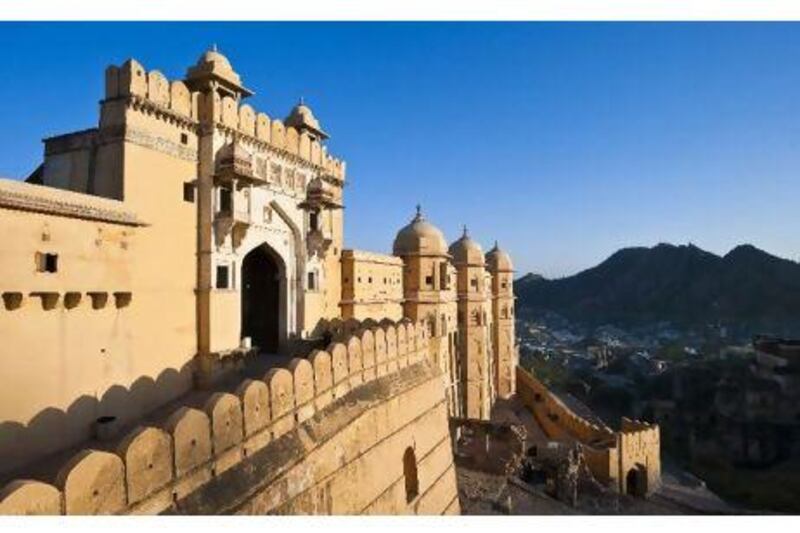Why Jaipur?
Jaipur, India's "pink city", is the definition of living history. Established by the Kachhawaha kings in the 12th century, the city's nickname comes from the colour of the sandstone used in most of the old buildings. Jaipur is today the capital of the desert state of Rajasthan (meaning the land of royals) and part of the justly famous travel circuit called the "golden triangle", along with New Delhi and Agra.
Jaipur is among the fastest-growing cities in India and can sometimes display all the signs of urban chaos but amid all that lie some of the most remarkable architectural achievements of the period. Two of the best are the Hawa Mahal (Palace of the Winds), Jantar Mantar, an ancient astronomical observatory built in the 1700s by Sawai Man Singh and, just over 15km away, is my personal favourite, the Amber Fort (pronounced Ah-mer), with its scintillating Sheesh Mahal (Palace of Mirrors), lush gardens and ornate pavilions.
For such a venerable old city, Jaipur has a youthful vibe, exemplified by its modern cafes and shopping malls. Middle-aged women in colourful saris, heads covered demurely, walk next to teenage girls in jeans and crop tops.
A comfortable bed
In Jaipur, the place to stay is one of the hotels housed in what used to be palaces or havelis (mansions), providing a glimpse into what life must have been like for the rich. The Diggi Palace (www.hoteldiggipalace.com; 00 91 141 237 3091) is a lovely mid-19th-century mansion and is surprisingly affordable, with double rooms from 5,000 rupees (Dh366) per night.
To really indulge, book a room at the Raj Vilas (www.oberoihotels.com/oberoi_rajvilas/index.asp; 00 91 11 2389 0606; double rooms from 38,000 rupees [Dh2,787] per night), an Oberoi property with impeccable standards of hospitality. Equally special is the Taj Rambagh Palace (www.tajhotels.com; 00 91 141 221 1919), once the residence of the maharaja of Jaipur. A richly appointed "palace" room can be had for 31,500 rupees (Dh2,310) per night.
Find your feet
Head to Hawa Mahal in the evening; that is where all of Jaipur congregates. The main markets are also located around this most familiar landmark. If you are brave enough, find a hand rickshaw to take you on a tour through the narrow streets or wander around on your own.
Better still, join a walking tour; there are several in the city catering to specific interests. I tried an extremely satisfying street-food tour on my own around the old city (warning: only for the iron-stomached). The "Bazaars, Cuisine and Craft" tour by the Virasat Foundation (www.virasatjourneys.com) is also a great introduction to the traditional arts and craft that live on in this city.
Because there is no public transport to speak of, your best bet is to find a friendly cab or rickshaw guy to take you around the main sights. Ideally, ask your hotel to fix it up for you but make it absolutely clear the driver is not to take you to workshops or showrooms, where they'll get kickbacks for bringing a potential buyer of overpriced crafts.
Meet the locals
All the buzz in Jaipur is centred around the local markets that branch out from the Nayi Chaupar (New Square), especially Johri Bazaar and Amber road in front of the Hawal Mahal. Any time of day, there are residents and tourists thronging the shops, bargaining and bantering over everything from shoes to spices. Rajasthanis are very friendly and love to stop and chat, even if they initially come across as slightly gruff.
Book a table
You cannot leave the city without a meal or, at the very least, a snack at the popular Lakshmi Mishthan Bhandhar (locally known as LMB) in Johri Bazaar. For those with a sweet tooth, LMB is heaven and the ghevar (deep-fried cakes) is its manna. If you are tired of spicy Indian food and crave comforting soups and sandwiches, make your way to Anokhi Cafe (www.anokhicafe.com), attached to the Anokhi Store in the neighbourhood known as C-Scheme.
For a special evening out, try 1135AD, Jaipur's most opulent (and, some say, most romantic) restaurant within the Amber Fort (www.1135ad.com/1135web/index.php). Enjoy a sumptuous Indian meal served by waiters in traditional attire while local musicians serenade you discreetly. The Thaal-e-amber Jeypoore, a platter of curries, kebabs and desserts, comes highly recommended. A meal for two costs around 3,000 rupees (Dh218).
Shopper's paradise
Anokhi (www.anokhi.com), famous for its elegant block prints and textiles, is one of the best places for shopping in Jaipur. Be sure to pick up some of the region's unique blue pottery from Neerja International (www.neerjainternational.com) on Jacob Road, Civil Lines. The city is also a great destination for gems and jewellery, especially the exquisite kundan style of the region. To avoid being cheated, stay clear of the smaller shops and head to Amrapali Jewels (www.amrapalijewels.com) on MI Road or inside the Rambagh Palace Hotel. Rajasthali (also on MI Road) is the government-managed handicrafts showroom; check out the variety and prices there before you buy from any other local shop.
What to avoid
There are touts everywhere, promising the "cheap and best" of everything. Watch out for spurious gem and jewellery dealers.
Don't miss
The Jaipur Literature Festival (www.jaipurliteraturefestival.org), the largest such annual event in India, will take place from January 20 to 24 at the Diggi Palace Hotel. Curated in the past by stalwarts such as William Dalrymple and Namita Gokhale, the 2012 festival has signed up a huge list of writers, including Annie Proulx, Mark Tully and David Hare. Entry is free.





